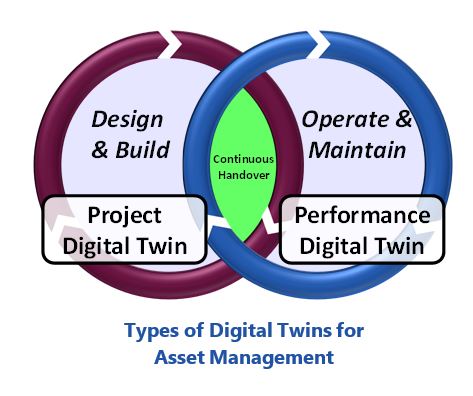

For asset management, two general types of digital twins have emerged – one for projects during plant design and build, and another for performance during operate and maintain by the asset owner/operators. This has led to some confusion in the market. By segmenting the types of digital twins in this manner, the respective features, applications, and benefits of each type of digital twin become clear.
Deconstructing the digital twin concept into its parts provides a foundation for understanding real digital twins. A digital twin reflects the properties of physical assets and the associated processes, and the underlying asset or process dictates its characteristics. Digital twins include the following elements:

Digital twins for asset management fall into two fundamental categories:
Project digital twins augment the design and construction of new equipment or plant upgrades. A 3D model with a timeline to simulate an activity identifies clashes, improves the construction sequence, and optimizes scheduling.
An example of a project digital twin in the automotive industry involves simulating the assembly line, including the movement of a car, assembly steps, and equipment paths. This helps identify and resolve clashes to reduce the time for commissioning and avoid re-work. For a new plant or an upgrade, simulating the construction sequence shortens project delivery time. For example, a large piece of equipment needs to be installed prior to completion of a wall or door that blocks transfer to its intended location.
Features of a project digital twin include:
Applications for project twins include:
Benefits used to financially justify a project digital twin:
The performance digital twins involve collecting real-time operational data, applying analytics to evaluate current conditions, and sending alerts when something deteriorates. Preventing unplanned downtime using predictive maintenance (PdM) is a common application for performance digital twins. Unplanned downtime often cascades into major losses including revenue, work-in-process (WIP) materials, and larger equipment repair costs.
PdM applications used to be expensive, difficult to support, and often abandoned when something changed that broke the software application. The introduction of cloud platforms with IoT and analytics lowered the application development costs and made it easier and more cost-effective to support the application over time. Rapid adoption of performance digital twins for PdM started in about 2015 due to the fast payback with preventing unplanned downtime and the associated revenue losses. Now, those PdM applications have started to expand in scope to include operational performance for quality, yield, energy conservation, and avoiding excessive stress from overrunning equipment.
ARC Advisory Group clients can view the complete report at ARC Client Portal
If you would like to buy this report or obtain information about how to become a client, please Contact Us
Keywords: Digital Twin, Asset Management, Plant Design, Operations, Maintenance, ARC Advisory Group.

